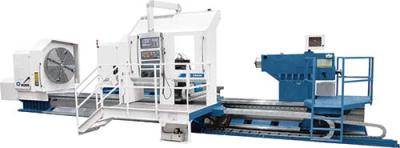
The C 1800H heavy-duty CNC Lathe from Romi is ideal for machining very large steel parts and components. Weighing in at 97,000 lbs., the lathe features a distance between centers from 157 to 394 inches, a 47-inch swing over cross slide, and a max weight capacity between centers of 66,100 lbs. at 50 rpm. The bed width and height are 55 inches and 30 inches, respectively.
Romi's C 1800H is part of the company's C series heavy-duty flatbed CNC lathes. Each model is built with Romi-made monoblock cast iron beds with hardened and ground guideways for optimum rigidity, accuracy, and performance. The C1800H features a 114 hp main motor and a geared A2-20" headstock with Timken precision bearings. It has a robust tailstock with thrust force monitoring and compensation system.
All critical components used to build Romi machine tools are designed and built in-house for complete control and manufacturing quality assurance. Each innovative Romi machine tool is designed and manufactured based on extensive customer research and feedback. This customer-centric approach to design allows Romi machine tool owners to innovate, grow and gain a competitive advantage.
Contact Details
Related Glossary Terms
- centers
centers
Cone-shaped pins that support a workpiece by one or two ends during machining. The centers fit into holes drilled in the workpiece ends. Centers that turn with the workpiece are called “live” centers; those that do not are called “dead” centers.
- computer numerical control ( CNC)
computer numerical control ( CNC)
Microprocessor-based controller dedicated to a machine tool that permits the creation or modification of parts. Programmed numerical control activates the machine’s servos and spindle drives and controls the various machining operations. See DNC, direct numerical control; NC, numerical control.
- lathe
lathe
Turning machine capable of sawing, milling, grinding, gear-cutting, drilling, reaming, boring, threading, facing, chamfering, grooving, knurling, spinning, parting, necking, taper-cutting, and cam- and eccentric-cutting, as well as step- and straight-turning. Comes in a variety of forms, ranging from manual to semiautomatic to fully automatic, with major types being engine lathes, turning and contouring lathes, turret lathes and numerical-control lathes. The engine lathe consists of a headstock and spindle, tailstock, bed, carriage (complete with apron) and cross slides. Features include gear- (speed) and feed-selector levers, toolpost, compound rest, lead screw and reversing lead screw, threading dial and rapid-traverse lever. Special lathe types include through-the-spindle, camshaft and crankshaft, brake drum and rotor, spinning and gun-barrel machines. Toolroom and bench lathes are used for precision work; the former for tool-and-die work and similar tasks, the latter for small workpieces (instruments, watches), normally without a power feed. Models are typically designated according to their “swing,” or the largest-diameter workpiece that can be rotated; bed length, or the distance between centers; and horsepower generated. See turning machine.
- quality assurance ( quality control)
quality assurance ( quality control)
Terms denoting a formal program for monitoring product quality. The denotations are the same, but QC typically connotes a more traditional postmachining inspection system, while QA implies a more comprehensive approach, with emphasis on “total quality,” broad quality principles, statistical process control and other statistical methods.






